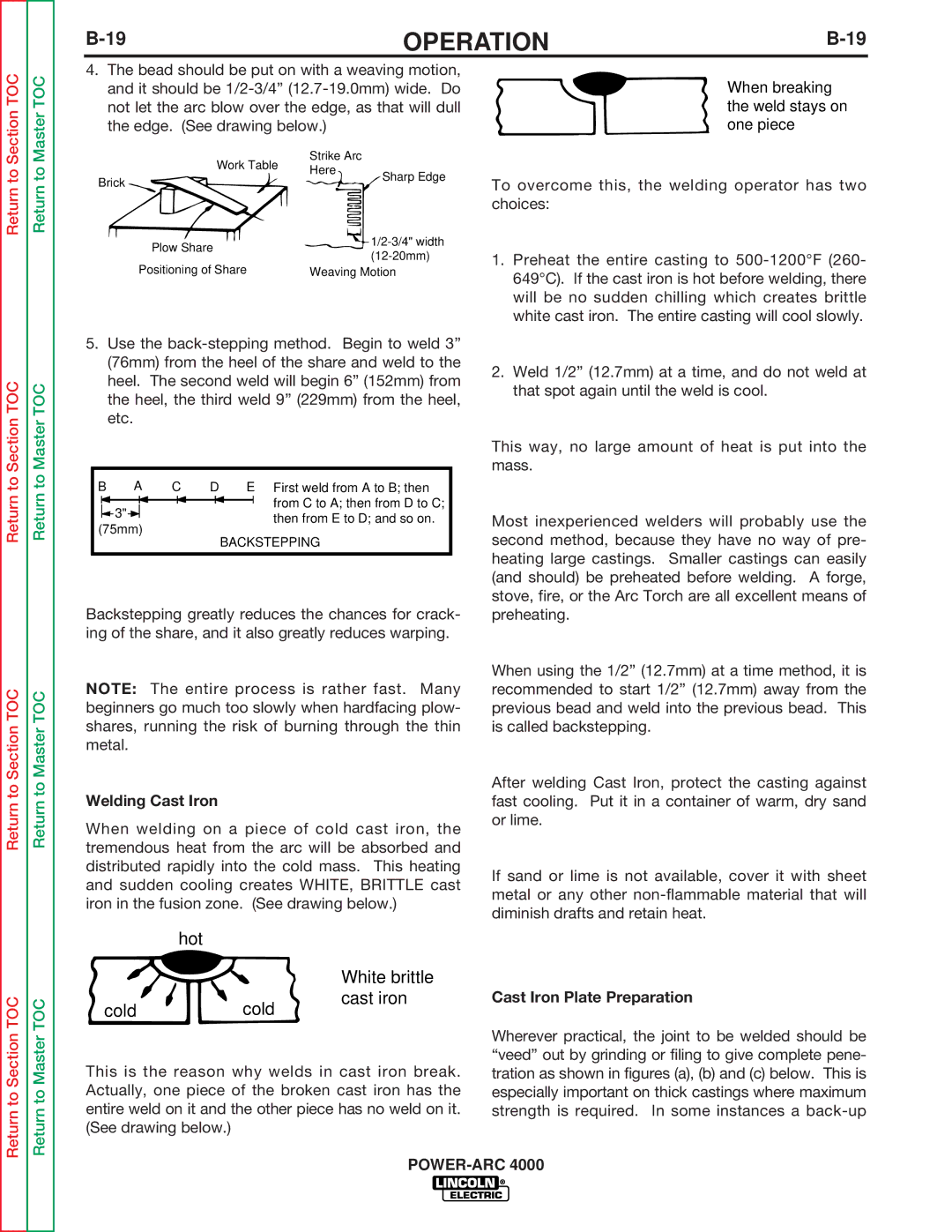
Section TOC
Master TOC
| OPERATION | ||
|
|
|
|
4. The bead should be put on with a weaving motion, |
| ||
and it should be | When breaking | ||
not let the arc blow over the edge, as that will dull | the weld stays on | ||
the edge. (See drawing below.) |
| one piece | |
Return to
Work Table | Strike Arc |
| |
Here | Sharp Edge | ||
Brick | |||
| |||
|
| ||
Plow Share |
| ||
| |||
|
| ||
Positioning of Share | Weaving Motion | ||
To overcome this, the welding operator has two choices:
1.Preheat the entire casting to
Return to Section TOC
Return to Section TOC
Return to Master TOC
Return to Master TOC
5.Use the
B | A | C | D | E First weld from A to B; then | |||||
|
| 3" |
|
|
|
|
|
| from C to A; then from D to C; |
|
|
|
|
|
|
|
| ||
|
|
|
|
|
|
|
| then from E to D; and so on. | |
(75mm) |
|
|
|
|
| ||||
|
|
|
| BACKSTEPPING | |||||
|
|
|
|
|
|
|
| ||
|
|
|
|
|
|
|
|
|
|
Backstepping greatly reduces the chances for crack- ing of the share, and it also greatly reduces warping.
NOTE: The entire process is rather fast. Many beginners go much too slowly when hardfacing plow- shares, running the risk of burning through the thin metal.
Welding Cast Iron
When welding on a piece of cold cast iron, the tremendous heat from the arc will be absorbed and distributed rapidly into the cold mass. This heating and sudden cooling creates WHITE, BRITTLE cast iron in the fusion zone. (See drawing below.)
2.Weld 1/2” (12.7mm) at a time, and do not weld at that spot again until the weld is cool.
This way, no large amount of heat is put into the mass.
Most inexperienced welders will probably use the second method, because they have no way of pre- heating large castings. Smaller castings can easily (and should) be preheated before welding. A forge, stove, fire, or the Arc Torch are all excellent means of preheating.
When using the 1/2” (12.7mm) at a time method, it is recommended to start 1/2” (12.7mm) away from the previous bead and weld into the previous bead. This is called backstepping.
After welding Cast Iron, protect the casting against fast cooling. Put it in a container of warm, dry sand or lime.
If sand or lime is not available, cover it with sheet metal or any other
Return to Section TOC
Return to Master TOC
hot
White brittle
cold | cold | cast iron | Cast Iron Plate Preparation |
|
| ||
|
|
| Wherever practical, the joint to be welded should be |
This is the reason why welds in cast iron break. | “veed” out by grinding or filing to give complete pene- | ||
tration as shown in figures (a), (b) and (c) below. This is | |||
Actually, one piece of the broken cast iron has the | especially important on thick castings where maximum | ||
entire weld on it and the other piece has no weld on it. | strength is required. In some instances a | ||
(See drawing below.) |
|
|
|
